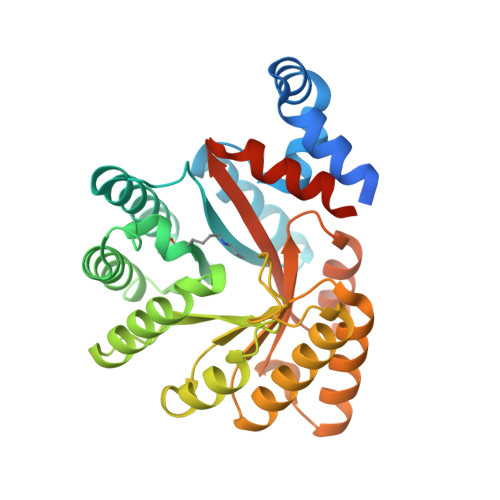Structural basis for the inactivation of Thermus thermophilus proline dehydrogenase by N-propargylglycine
White, T.A., Johnson, W.H., Whitman, C.P., Tanner, J.J.(2008) Biochemistry 47: 5573-5580
- PubMed: 18426222
- DOI: https://doi.org/10.1021/bi800055w
- Primary Citation of Related Structures:
2EKG - PubMed Abstract:
The flavoenzyme proline dehydrogenase catalyzes the first step of proline catabolism, the oxidation of proline to pyrroline-5-carboxylate. Here we report the first crystal structure of an irreversibly inactivated proline dehydrogenase. The 1.9 A resolution structure of Thermus thermophilus proline dehydrogenase inactivated by the mechanism-based inhibitor N-propargylglycine shows that N5 of the flavin cofactor is covalently connected to the -amino group of Lys99 via a three-carbon linkage, consistent with the mass spectral analysis of the inactivated enzyme. The isoalloxazine ring has a butterfly angle of 25 degrees , which suggests that the flavin cofactor is reduced. Two mechanisms can account for these observations. In both, N-propargylglycine is oxidized to N-propargyliminoglycine. In one mechanism, this alpha,beta-unsaturated iminium compound is attacked by the N5 atom of the now reduced flavin to produce a 1,4-addition product. Schiff base formation between Lys99 and the imine of the 1,4-addition product releases glycine and links the enzyme to the modified flavin. In the second mechanism, hydrolysis of N-propargyliminoglycine yields propynal and glycine. A 1,4-addition reaction with propynal coupled with Schiff base formation between Lys99 and the carbonyl group tethers the enzyme to the flavin via a three-carbon chain. The presumed nonenzymatic hydrolysis of N-propargyliminoglycine and the subsequent rebinding of propynal to the enzyme make the latter mechanism less likely.
Organizational Affiliation:
Department of Chemistry , University of Missouri-Columbia, Columbia, Missouri 65211, USA.

















